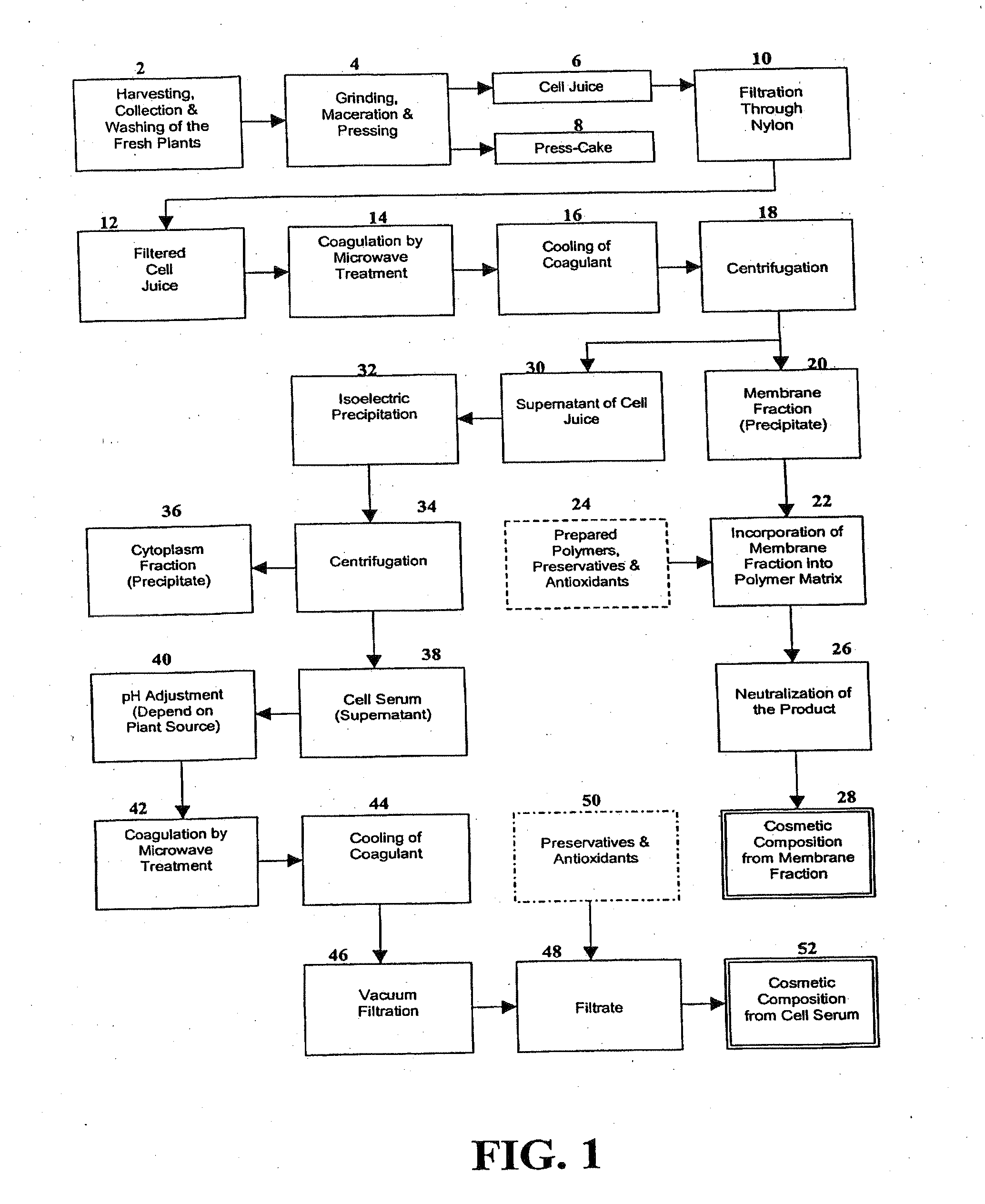Bioactive botanical cosmetic compositions and processes for their production
a bioactive botanical and composition technology, applied in the field of bioactive botanical cosmetic compositions, can solve the problems of inconvenient use, increased risk of microbiological contamination and proliferation, and loss of potency of many bioactive botanical cosmetic ingredients now used in cosmetic formulations, and achieves significant bioactivity potency and a smooth skin. elasticity
- Summary
- Abstract
- Description
- Claims
- Application Information
AI Technical Summary
Benefits of technology
Problems solved by technology
Method used
Image
Examples
example 1
Preparation of Cosmetic Botanical Ingredient 101 Derived from Alfalfa (Medicago sativa) Cell Serum Fractions
[0095]Biomass Preparation. Sufficient amounts of fresh alfalfa (Medicago sativa) plant biomass (i.e., stem and leaf tissue) were harvested to yield approximately 100 kg of dry matter. The level of dry matter in the fresh alfalfa plant biomass was calculated to be 15.75 percent, requiring harvesting of approximately 635 kg of fresh alfalfa plant biomass to yield 100 kg of dry matter. Care was taken to preserve the inherent moisture content of the plant biomass and to avoid wilting due to moisture loss. The plants were cut at least 5 centimeters above the ground to limit the amount of soil and other debris in the collected plant biomass. The cutting was conducted in such a manner as to avoid or minimize chopping, mashing, and crushing of the plants. The harvested plants were delivered for processing not more than 60 minutes after cutting. This was done to minimize exposure of th...
example 2
Product Specifications of Cosmetic Botanical Ingredient 101 Derived from Alfalfa (Medicago sativa) Cell Serum Fractions
[0099]Cosmetic Botanical Ingredient 101 was prepared according to the process described above in Example 1. Analyses of Cosmetic Botanical Ingredient 101 were conducted to determine its various physico-chemical, microbial, cytotoxicity, and bioactivity characteristics, as described below. Cosmetic Botanical Ingredient 101 is a clear liquid, which has a light-yellow color and a light-characteristic odor. No solvent (i.e. glycol, oil, or water) was added to the carrier medium.
[0100]Table 1 summarizes the Physical and Chemical data of Cosmetic Botanical Ingredient 101.
TABLE 1Physical and Chemical DataParameterMethodResultsSolid Content, %See Example 25,5.3“Method 1”Specific Gravity, g / cm3USP 1.025ColorGardner Scale6-7Refractive IndexUSP 1.342pHUSP 4.1Red-Ox Potential, mVSee reference [1]70Conductivity, S / mSee reference [2]0.96References:[1] Handbook of Chemistry and Ph...
example 3
Preparation of Cosmetic Botanical Ingredient 201 Derived from Barley (Hordeum vulgare) Cell Serum Fractions
[0104]The process for preparing Cosmetic Botanical Ingredient 201 was identical to the process described in Example 1 with regard to Cosmetic Botanical Ingredient 101, with the variations noted below. Fresh stem and leaf tissue of barley (Hordeum vulgare) was used as the plant biomass starting material. The level of dry matter in the fresh barley plant biomass was calculated to be 13.67 percent, requiring harvesting of approximately 732 kg of fresh barley plant biomass to yield 100 kg of dry matter. The preparation resulted in the production of 15.1 kg of Dry Matter yield (or approximately 433 liters) of Cosmetic Botanical Ingredient 201.
PUM
 Login to View More
Login to View More Abstract
Description
Claims
Application Information
 Login to View More
Login to View More - R&D
- Intellectual Property
- Life Sciences
- Materials
- Tech Scout
- Unparalleled Data Quality
- Higher Quality Content
- 60% Fewer Hallucinations
Browse by: Latest US Patents, China's latest patents, Technical Efficacy Thesaurus, Application Domain, Technology Topic, Popular Technical Reports.
© 2025 PatSnap. All rights reserved.Legal|Privacy policy|Modern Slavery Act Transparency Statement|Sitemap|About US| Contact US: help@patsnap.com


